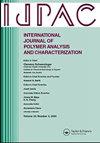Impact of cellulose supramolecular structure on its carboxymethylation reaction activity
IF 1.6
4区 工程技术
Q4 POLYMER SCIENCE
International Journal of Polymer Analysis and Characterization
Pub Date : 2025-04-03
DOI:10.1080/1023666X.2025.2463520
引用次数: 0
Abstract
The reaction activity of cellulose samples is determined according to their supramolecular structure, especially the degree of crystallinity and degree of polymerization. The carboxymethylation reaction kinetics of cotton cellulose (CC), microcrystalline cellulose (MCC), and powder cellulose (PC), with different degrees of crystallinity and degree of polymerization, were studied by the solid-phase method and in an ethanol-water solution medium. In the row of CC, MCC, and PC with different supramolecular structures, it was found that with decreasing crystallinity degree of the raw materials, during carboxymethylation by the solid-phase method and in an ethanol-water solution medium, the degree of substitution (DS) of sodium-carboxymethylcellulose (Na-CMC) increased. In this row, the activation energy values of the carboxymethylation reaction of CC, MCC, and PC were 27.79, 18.30, and 10.74 kJ/mol, respectively, by the solid-phase method. Furthermore, the activation energies of the carboxymethylation reaction of CC, MCC, and PC were 59.26, 25.20, and 17.59 kJ/mol, respectively, in an ethanol-water solution medium. Decreasing activation energies led to an increase in the reaction activity, which, after CC, MCC, and PC carboxymethylation, the DS of Na-CMC reached 0.63, 0.86, and 0.97, respectively, using the solid-phase method. In an ethanol solution medium, the DS values of Na-CMC reached 0.89, 1.10, and 1.31 after carboxymethylation of the CC, MCC, and PC, respectively.
纤维素超分子结构对其羧甲基化反应活性的影响
纤维素样品的反应活性取决于其超分子结构,尤其是结晶度和聚合度。采用固相法,在乙醇-水溶液介质中研究了不同结晶度和聚合度的棉纤维素(CC)、微晶纤维素(MCC)和粉末纤维素(PC)的羧甲基化反应动力学。在具有不同超分子结构的 CC、MCC 和 PC 行中发现,随着原料结晶度的降低,在固相法和乙醇-水溶液介质中进行羧甲基化时,羧甲基纤维素钠(Na-CMC)的取代度(DS)增加。在这一行中,固相法中 CC、MCC 和 PC 羧甲基化反应的活化能值分别为 27.79、18.30 和 10.74 kJ/mol。此外,在乙醇-水溶液介质中,CC、MCC 和 PC 的羧甲基化反应活化能分别为 59.26、25.20 和 17.59 kJ/mol。活化能的降低导致反应活性的提高,在固相法中,CC、MCC 和 PC 羧甲基化后,Na-CMC 的 DS 分别达到 0.63、0.86 和 0.97。在乙醇溶液介质中,CC、MCC 和 PC 羧甲基化后,Na-CMC 的 DS 值分别达到 0.89、1.10 和 1.31。
本文章由计算机程序翻译,如有差异,请以英文原文为准。
求助全文
约1分钟内获得全文
求助全文
来源期刊
CiteScore
3.50
自引率
5.30%
发文量
37
审稿时长
1.6 months
期刊介绍:
The scope of the journal is to publish original contributions and reviews on studies, methodologies, instrumentation, and applications involving the analysis and characterization of polymers and polymeric-based materials, including synthetic polymers, blends, composites, fibers, coatings, supramolecular structures, polysaccharides, and biopolymers. The Journal will accept papers and review articles on the following topics and research areas involving fundamental and applied studies of polymer analysis and characterization:
Characterization and analysis of new and existing polymers and polymeric-based materials.
Design and evaluation of analytical instrumentation and physical testing equipment.
Determination of molecular weight, size, conformation, branching, cross-linking, chemical structure, and sequence distribution.
Using separation, spectroscopic, and scattering techniques.
Surface characterization of polymeric materials.
Measurement of solution and bulk properties and behavior of polymers.
Studies involving structure-property-processing relationships, and polymer aging.
Analysis of oligomeric materials.
Analysis of polymer additives and decomposition products.

 求助内容:
求助内容: 应助结果提醒方式:
应助结果提醒方式:


